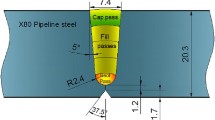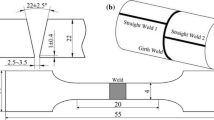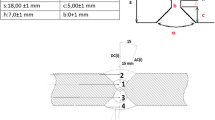Abstract
The weld defects were detected by Nondestructive Testing Technology(NTT). The microstructure and microhardness were examined by optical microscope(OM), scanning electron microscopy (SEM) equipped with EDS and Vicker microhardness tester to identify the reasons of cracking failure in X70 pipeline steel weldment. As a result, the microstructure in the root layer and filling layer of the weld presents ferrite and pearlite while it is ferrite and bainite in the covering layer, but the morphology and distribution as well as the content of ferrite and pearlite in the root layer are different from which in the filling layer; the cracks initiate at the root of the weld and propagate towards filling layer, and the C, O, S segregation is serious, which contribute to the initiation and propagation of the crack in the weld; the hardness decreases sharply around the crack tip, which exhibits lower strength.
Access provided by CONRICYT-eBooks. Download conference paper PDF
Similar content being viewed by others
Keywords
Introduction
Currently, the increasing demand for oil and natural gas has forced energy industries to look for these resources in harsh environment. There is no doubt that steel pipelines are often used to carry these resources for long distances. The most important damage style in pipeline steels is crack in the weld which will lead to leakage and result in enormous losses. Also, the leakage or rupture of these pipelines can always pose a potential threat to humans and environment. So it is important to investigate the reasons of crack in the weld of pipelines in order to occupy a high quality weld.
Meresht [1] investigated the causes of stress corrosion cracking of API 5L X60 steel gas pipeline that was installed in the northern regions of Iran concluding that possible susceptibility to Stress Corrosion Cracking(SCC) failures of such pipelines was resulted from active defects on external surface. Mohtadi-Bonab [2] studied the mechanism of failure by hydrogen induced cracking in an acidic environment for API 5L X70 pipeline steel, and found that the role of high angle grain boundaries and type of fracture would be important in crack propagation. Welding process is a nonequilibrium thermodynamics process, often introducing several defects in the welding process, which will have a strong impact on servicing safety of pipeline steels. Based on this concept, a lot of works are done by scholars. Azevedo [3] investigated the transversal cracking of a seamed API 5L X46 steel tube belonging to a crude oil pipeline, considering the nucleation of the primary crack was associated to the presence of welding defects and corrosion pits. Fu [4] analyzed the cracking in girth weld of pipeline used in gasfield gathering system, concluding that the mechanically lined pipe crack initiated from outer carbon steel, and propagated in intergranular mode along the weld-fusion line. In order to identify causes of an incident taken place after an operation to repair a leak in an interstate natural gas pipeline, Farzadi [5] conducted a failure analysis which concluded that hydrogen-assisted cracking, wrong design of branch connection, paint coating, and pipeline operating conditions were major factors contributing to the failure.
The cracking failure may cause pollution, loss of production and even life danger. So it is necessary to deeply investigate the failure or defects reasons in the weld of the pipelines. The objective of this paper is to analyze the cracking failure reasons of girth weld in X70 pipeline steel.
Background of the Failure
The failed two segments of the X70 weld were shown in Fig. 1 containing inner pipe (a, c); and outer pipe (b, d). The cracking failed girth weld in X70 pipeline was firstly detected by X-ray detectoscope, and the results were shown in Fig. 2. It was found from Fig. 2 that three places of crack points appeared in the weld, and the three places of crack points were circled out in Fig. 1.
Failure Description and Analysis
-
Failure Description. In order to further exact the locations of detected defects, a Multi-function Ultrasonic Phased-array Detection System (SYNCSCAZ 16PT) was used to the three failure points. Then the three defects were extracted from the base metal using and were marked 1#, 2#, 3#, respectively. Specimen were prepared from the transverse cross section of the weld.
Morphology characterization of three defects in the weld of X70 pipeline steel was shown in Fig. 3. It was obvious that arc crater, excessive grind and a lower thickness of weld which compared to base metal all existed in 1# and 2#; lots of spatter on the back of the weld appeared in 1#, and also, serious undercut as well as spatter existed in 3#. These defects in the weld surface will introduce stress concentration, and induce crack initiation in the defects places [6]. The three specimen were cut by Wire cut Electrical Discharge Machining (WEDM) according to the Multi-function Ultrasonic Phased-array Detection System and prepared by grinding using 150, 240, 600, 1000, 2000, 3000 and 5000 grits of SiC paper and polished, then etched by nitric acid alcohol solution(4%). The microstructure features were studied using optical microscope (OM), and the results were shown in Fig. 4. It is obvious that there are three porosities locating in the filling layer in 1#, while it is a crack in the weld in 2#, and the crack initiates from central position of the weld root, extends towards filling layer and ends at the filling layer. When it comes to 3#, however, the crack initiates from undercut position of the weld root, circuitously extends towards filling layer and ends at the filling layer.
To sum up, the cracks all initiate from the weld root, and extend towards filling layer, which may relate to the different microstructure, composition of the weld. So microstructure investigations, EDS analysis as well as microhardness test were conducted in order to better understand the reasons of the weld cracking in X70 pipeline.
Failure Analysis
Microstructure Observation. It is observed that there are three porosities locating in the filling layer in 1# and the enlarged morphology is shown in Fig. 5. The microstructure of the layer where porosities are located in is shown in Fig. 6. It can be confirmed from Fig. 6a that the irregular porosity which may result from the incomplete cleaning of the weld, is located in the filling layer and is adjacent to the root layer. The existence of irregular porosity will reduce force bearing area, contribute to stress concentration and then promote the formation and extension of crack [6, 7]. Figure 6b–d are microstructure of root layer, filling layer, and covering layer; respectively; it is a mixture of ferrite and pearlite in root layer and filling layer while some bainite structure formed in the covering layer; however, as the root welding process has a similarly effect with preheat on the filling welding, it formed more pro-eutectoid ferrite and less pearlite in filling layer compared with the root layer.
The observed result of 2# is crack formed in weld. Figure 7 shows the microstructure of the weld where the crack is located in. The microstructure of each layer in 2# is similar to 1# because of the same welding process. There is an obvious notch in the root weld according to Fig. 7a, which may be the result of excessive grind to the weld reinforcements after welding process. This notch destroyed integrity and consistency of the weld, leaving a local damage on the surface and resulting in stress concentration [8], thus it will promote the original crack beside the notch extend to the weld with the comprehensive effect of flowing petroleum and natural gas in the pipeline, corrosion, etc. The crack originated from the weld root, then propagated irregularly and tortuously towards filling layer. In order to further investigate the crack propagation, a SEM observation was conducted. The result is shown in Fig. 8. It can be seen from Fig. 8a that the crack is located in the root layer and propagate irregularly and tortuously along a path shown in Fig. 8b. From Fig. 8c, there formed inclusion in the crack tip, and the inclusion has an effect on the crack propagation that the crack is arrested here. It can be speculated as the following views: firstly, ferrite can sustain some deformation [9] because of its excellent plasticity, then some stress can be released; secondly, as the inclusion has higher strength, the crack propagation can be effectively restrained.
The microstructure of each layer of 3# is shown in Fig. 9. The observation results indicate that the microstructure is mainly ferrite and pearlite. Figure 9a shows that crack originates from the undercut area and propagate towards weld center along the fusion line. The main reason is that edge offset exceed the technological procedure, which increased stress concentration and prompted the crack initiation. Besides, the heat affected zone experienced most serious edge offset, contained most serious stress centration, resulted in crack initiation and propagation under service environment. The crack width increased during propagation from fusion line to root weld center, and stopped at the filling layer. For one thing, the microstructure in heat affected zone refined a lot compared with root layer according to Fig. 9b, e; for another, although some stress was released, there were still stress concentration existed in the weld, and this prompted the crack propagated to coarse grain of root welding layer, then stopped with the comprehensive effect of some inclusion and ferrite as well as pearlite.
-
Element Distribution Analysis. In order to further investigate the reason of crack initiation and propagation, EDS analysis was conducted.
Figure 10 shows the surface scan result of porosity in 1#. The observation results show that there is more O element distributing along the crack edge alongside the porosity, which indicates that the crack may result from the oxide.
Figure 11 shows the point scan and surface scan results of crack in 2#. It can be concluded that element segregation is serious during welding process, and it is easy to form brittle inclusions [10]. On one hand, these brittle inclusions can not deform effectively to release stress; on another hand, they can also constrain crack propagation. Figure 11f shows the surface scan result of crack tip of 2#. It indicates that the beneficiation of C, S and O is serious.
Figure 12 shows the point scan and surface scan results of crack tip in 3#. It is also a beneficiation of C, S and O elements. These two elements can easily form brittle inclusion together with Si, Cr,Mn, Ti. As an oxidation environment can significantly accelerates crack growth rates, rather than temperature alone [11]. So it is important to control those elements like O, S.
-
Microhardness Analysis. Microhardness test was conducted by tester HVD-2000TM/LCD at room temperature. 1# and 3# are selected for testing. As those defects are mainly distributed at filling layer, so the selected position is filling layer. The results are shown in Fig. 13. It can be clearly seen that the microhardness distribution is almost the same for the weldments with 1# and 3# that the microhardness values in the weld are all lower than base metal. The grain size in the weld is more coarse than heat affected zone and base metal, leading to a lower microhardness value in the weld. So it is important to control the grain size by controlling heat input and interpass temperature during welding process.
Conclusion
The microstructure and microhardness were investigated to better elucidate the reason of cracking failure of X70 pipeline steel weld. The following conclusions can be made based on the aforementioned results:
-
1.
The microstructure in the weld of X70 pipeline shows different distribution of ferrite and pearlite in root layer and filling layer, which is resulted different welding thermal cycle.
-
2.
The enrichment of C, O, S in the crack position is serious which will contribute to the growth of crack.
-
3.
The grain size can deeply influence the microhardness value, so the methods such as heat input and interpass temperature should be taken to control the grain size.
References
E.S. Meresht, T.S. Farahani, J. Neshati, Failure analysis of stress corrosion cracking occurred in a gas transmission steel pipeline. J. Eng. Fail. Anal. 18, 963–970 (2011)
M.A. Mohtadi-Bonab, J.A. Szpunar, R. Basu et al., The mechanism of failure by hydrogen induced cracking in an acidic environment for API 5L X70 pipeline steel. J. international journal of hydrogen energy. 40, 1096–1107 (2015)
C.R.F. Azevedo, Failure analysis of a crude oil pipeline. J. Eng. Fail. Anal. 14, 978–994 (2007)
A.Q. Fu, X.R. Kuang, Y. Han et al., Failure analysis of girth weld cracking of mechanically lined pipe used in gasfield gathering system. J. Eng. Fail. Anal. 68, 64–75 (2016)
A. Farzadi, Gas pipeline failure caused by in-service welding. J. Pressure Vessel Technol. 138, 011405 (2016)
H. Alipooramirabad, A. Paradowska, R. Ghomashchi et al., Investigating the effects of welding process on residual stresses, microstructure and mechanical properties in HSLA steel welds. J. Manuf. Process. 28, 70–81 (2017)
F. Shen, B. Zhao, L. Li et al., Fatigue damage evolution and lifetime prediction of welded joints with the consideration of residual stresses and porosity. Int. J. Fatigue. 163, 272–279 (2017)
T. Łagoda, P. Biłous, Ł. Blacha, Investigation on the effect of geometric and structural notch on the fatigue notch factor in steel welded joints. Int. J. Fatigue 101, 224–231 (2017)
Wang A, Shi Y, Chen C, Effect of aging-deformation-treatment on the formation of intragranular ferrite in V-microalloyed steel. J. Mater. Sci. Technol. 1–6 (2017)
Natividad C, García R, López VH et al. Metallurgical characterization of API X65 steel joint welded by MIG welding process with axial magnetic field. J. Mater. Res. 8–17 (2017)
R. Jiang, S. Everitt, N. Gao et al., Influence of oxidation on fatigue crack initiation and propagation in turbine disc alloy N18. J. Int. Fatigue. 75, 89–99 (2015)
Author information
Authors and Affiliations
Corresponding author
Editor information
Editors and Affiliations
Rights and permissions
Copyright information
© 2018 Springer Nature Singapore Pte Ltd.
About this paper
Cite this paper
Wang, B., Zhang, S., Zhou, C., Liu, N., Wang, L., Tian, X. (2018). Cracking Failure Analysis of X70 Pipeline Steel Weld. In: Han, Y. (eds) Advances in Energy and Environmental Materials. CMC 2017. Springer Proceedings in Energy. Springer, Singapore. https://doi.org/10.1007/978-981-13-0158-2_40
Download citation
DOI: https://doi.org/10.1007/978-981-13-0158-2_40
Published:
Publisher Name: Springer, Singapore
Print ISBN: 978-981-13-0157-5
Online ISBN: 978-981-13-0158-2
eBook Packages: EnergyEnergy (R0)

















